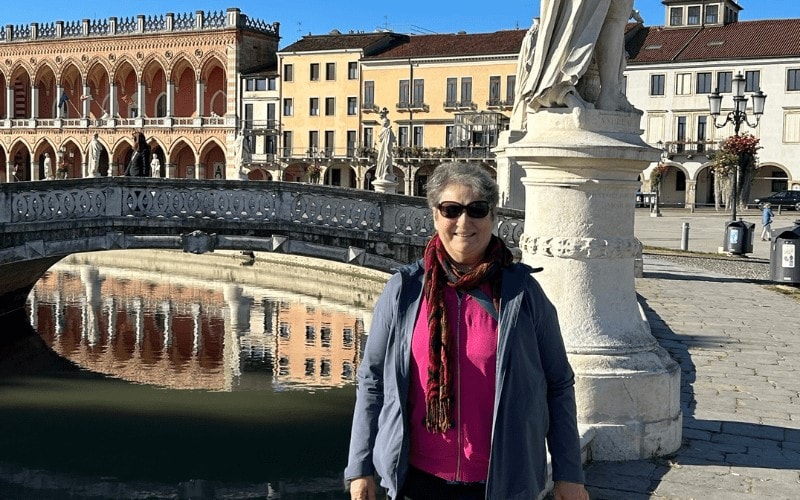A Week in Fascinating Little Padua Reveals Hidden Treasures
Thinking of visiting Padua. Called Padova in Itatlian, this historic city in northern Italy is just a quick train ride from Venice.
With plenty of things to do and see, Padua will keep the Artsy Traveler well entertained for several days.
In this post, I share how I spent my week in Padua that included day trips to Venice and Vicenza.
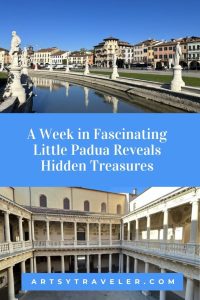
Padua Highlights at a Glance
- Staring awestruck at the Giotto frescoes in the Scrovegni Chapel
- Exploring the fascinating anatomical theater
- Hanging out in the stunning Prato della Valle
- Staying in an apartment as a temporary local
- Taking a day trip to Vicenza
Overview
So why was I in Padua for a week, instead of Venice, its more famous neighbor? First, I’ve visited and stayed in Venice several times and felt it was time to explore more of the Veneto. Second, my husband Gregg Simpson (who is an artist) had an exhibition in Padua.
I’d heard Padua was worth visiting in its own right and so looked forward to exploring this new-to-us town. I visited in November–a chilly time in northern Italy (take a good, warm coat!).
On the upside, late November is also the time of the Chocolate Festival where dozens of booths groaning with all kinds of chocolate confections lined the piazzas in the center of Padua. Needless to say, we sampled our fair share.
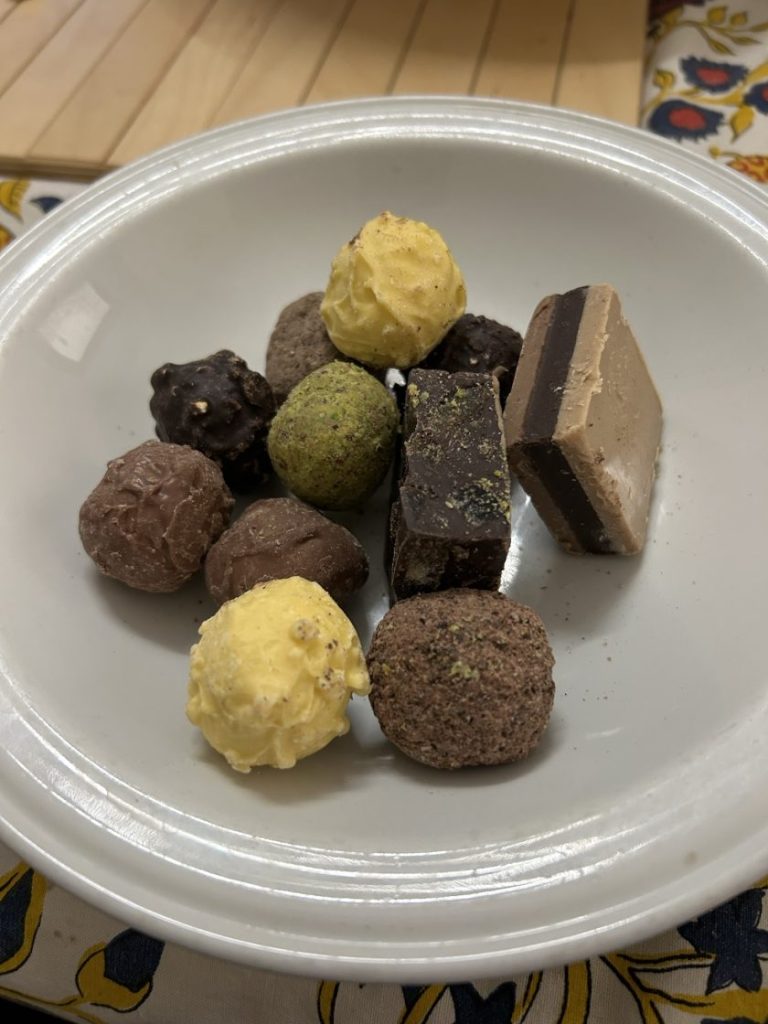
Give Padua At Least Two Days
In your travel planning, don’t make Padua and Venice an either/or option. Instead, build time in your itinerary to visit both.
You can easily see Padua’s main attractions and enjoy the laid-back ambiance in a relaxed three-night stay, or keep yourself busy for a week like I did.
If you only have time to make a short stop in the city of Padua, then squeeze in a flying visit to Padua’s main Artsy Traveler highlight–the Giotto frescsoes in the Scrovegni Chapel. Just make sure you’ve booked well in advance of your visit (more on that in a minute).
But a day in Padua is not enough. I suggest you slow down, book a place in Padua’s historic city center, and stay awhile. There are plenty of things to do in Padua, which yields up its treasures with a measured delight.
Map of Padua
The map below includes all of the sites mentioned in this post in addition to the location of the wonderful apartment I rented, about a 15-minute walk from the center of town.
- Scrovegni Chapel
- Musei Civici Eremitani
- Anatomical Theatre of Padua in the Palazzo Po
- University of Padua Botanical Garden
- Prato dell Valle
- Padua Cathedral
- Recommended Apartment on the Via dell Palme
- Piazza dei Signori
- Piazza della Erbe
- Palazzo della Ragione
Scrovegni Chapel
I’ll start with the heaviest hitter of them all, sightseeing-wise–the Giotto frescoes in the Scrovegni Chapel known in Italian as the Cappella degli Scrovegni. On any Padua itinerary, the Scrovegni Chapel deserves the top spot.
I visited on Day 7 of my stay in Padua, which made for a stunning finale to our week.
When I left the next day to fly home from Milan, visions of Giotto’s exquisitely rendered figures still danced in my head.
Buy Tickets for the Scrovegni Chapel in Advance
As soon as you know the date you plan to be in Padua, buy your tickets for the Scrovegni Chapel, the earlier the better.
Don’t wait until the last minute! The chapel was sold out weeks in advance of my November visit. Same-day tickets are not available.
Here’s the link to purchase tickets from the official site. If tickets are sold out on the official site you may be able to get a ticket by signing up for a tour through GetYourGuide. Here’s an option:
Once you’ve booked your ticket, just show up at your appointed time and prepare to be blown away.
Starting Your Scrovegni Chapel Visit
Your visit starts with a walk through beautifully landscaped gardens from the visitor center to the chapel. Since everyone who visits the chapel must book in advance, you pretty much have the place to yourself apart from the thirty or so people who will be in your viewing group.
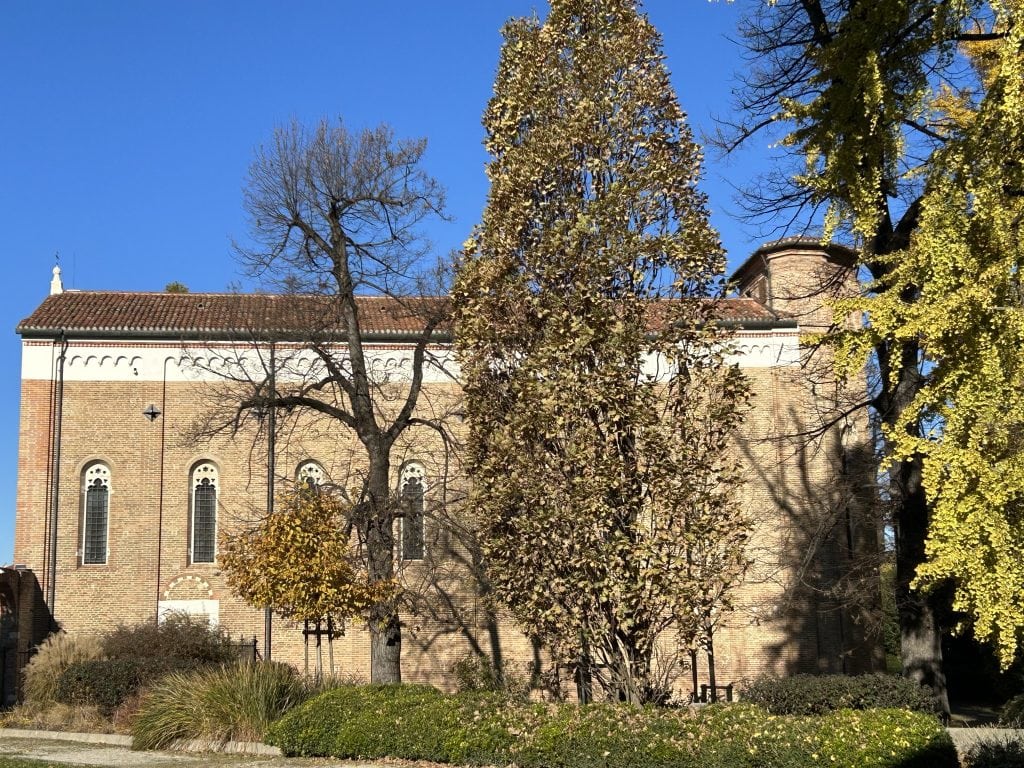
You arrive outside the hermetically sealed doors that separate you from a specially built anteroom adjacent to the chapel.
Make sure you arrive a good ten minutes early. The visits are timed very precisely with no provisions made for latecomers.
At your appointed time–not a second too early or too late–the automatic doors swish open. You glimpse the party who visited the chapel before you leaving from another door as you file into the anteroom and take a seat.
Here you will watch a fascinating video (English subtitles) about Giotto’s world-famous frescoes.
I’m partial to 14th Century Italian art and as such, I’m a bit of a Giotto fan girl. I thoroughly enjoyed the description of the fresco cycle. The work is considered one of Giotto’s greatest masterpieces, and is a wonderful example of the artistic revolution that Giotto brought to Western art.
Giotto completed the frescoes in just two years, between 1303 and 1305. The frescoes cover the entire interior of the Chapel and narrate the History of Salvation.
Entering the Chapel
After the film, you are invited to stand. Seconds later, another automatic door swishes open and finally, you file into the chapel itself. Gasps of wonder fill the air as each individual quietly takes in the awe-inspiring frescoes.
Guides are prohibited so the only sounds are whispers and the muted blips of cell phones and cameras (no flashes allowed, of course) making futile attempts to capture the majesty of the space.
It’s impossible. Pictures don’t do it justice, but here are a few of mine, to give you an idea of what you’ll see.
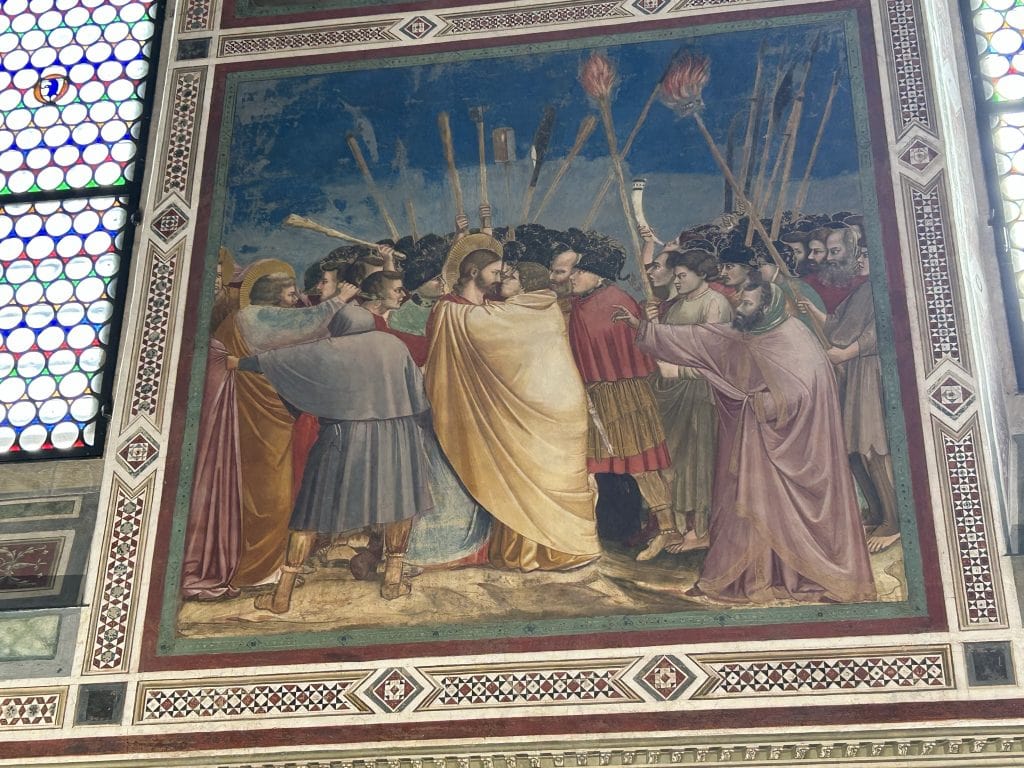
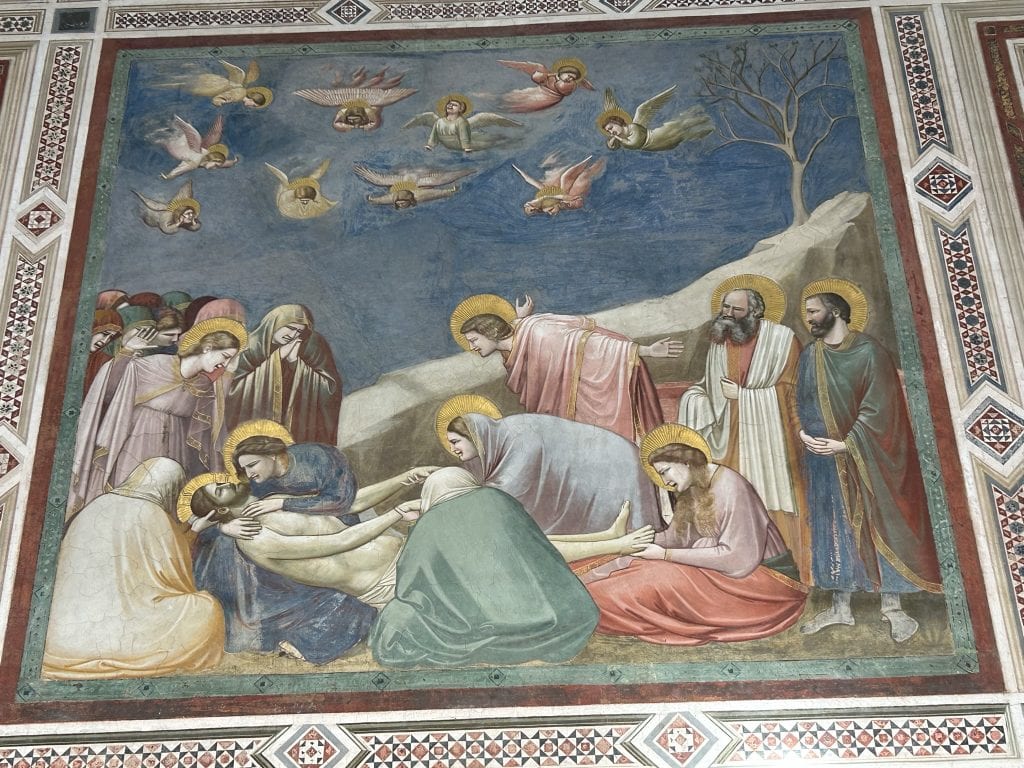
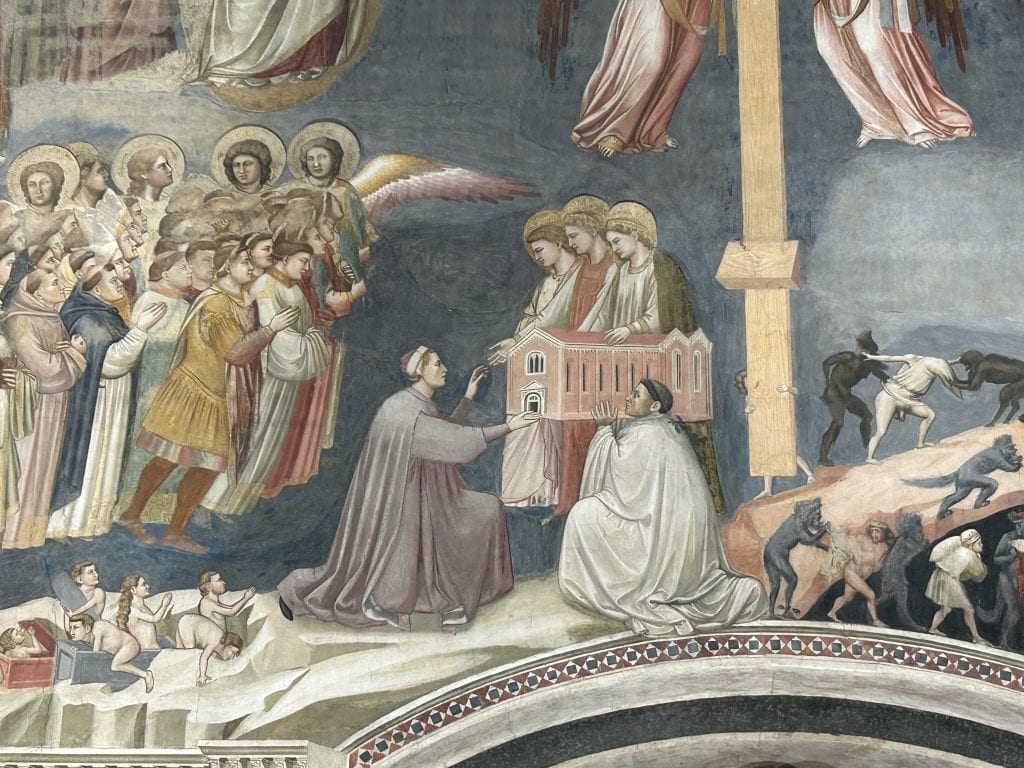
Why Giotto?
The big deal about Giotto is the naturalism of his figures–a major departure from the stiff, 2D figures common at the time. Giotto’s figures look like real people wearing clothes that drape naturally over real bodies.
You get precisely 15 minutes to enjoy the chapel before the automatic doors again swish open and you file out.
On your way, you see the next group preparing to enter, and envy them their first glimpse of the chapel interior. All you have now are your pictures and your memories.
Musei Civici Eremitani
After visiting the Chapel, you can visit the Musei Civici Eremitani, which contains the Archaeological Museum of Padua and the Museum of Medieval and Modern Art. Both are worth checking out.
Archaeological Museum of Padua
Padua is one of the oldest cities in Italy, which becomes abundantly clear when you visit the Archaeological Museum.
Here, you’ll find a fascinating collection from the pre-Roman era (8th-3rd century BC), decorated vases from the third Atestine period (6th-5th century BC), Paleo-Venetian steles, votive objects, Etruscan, Italic and Paleo-Venetian bronzes, Egyptian art, and an extensive Roman section.
If you like ancient artifacts, this museum is definitely worth a visit.
Museum of Medieval and Modern Art
The museum contains around 3000 paintings from the 14th to the 19th centuries, including works by such luminaries as Giorgione, Tiziano Vecellio, Giotto, Tintoretto, Veronese, Canova, Tiepolo, and Bellini, among many others.
Anatomical Theater in the Palazzo Bo
My cousin, who is a physician, advised me to visit the anatomical theater at the University of Padua, and I’m very glad I did.
It’s accessible only via an entertaining guided tour given in English by a student. In addition to visiting the famous anatomical theater, you’ll view some of the ornately decorated public rooms in the Palazzo Bo, which is part of one of Europe’s oldest universities.
You’ll also learn that Galileo Galilei was a professor at the University of Padua from 1592 to 1610.
Tour of the Palazzo Po
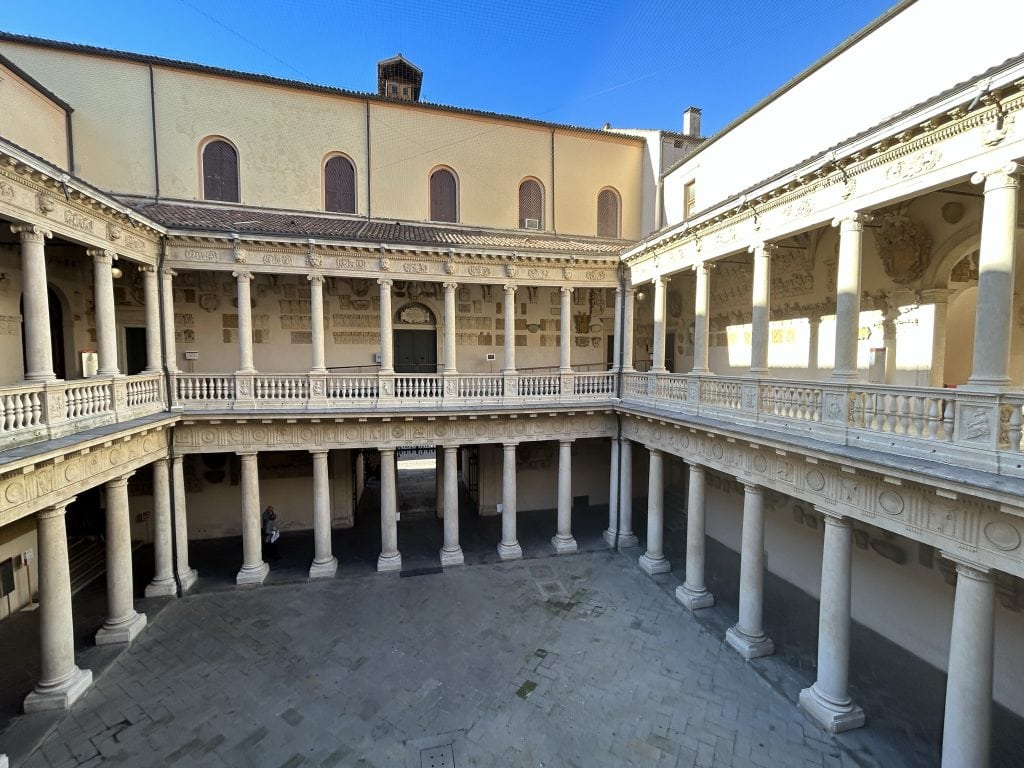
I very much enjoyed the tour of the Palazzo Bo that included these striking murals of some of the university’s most illustrious students over the centuries.
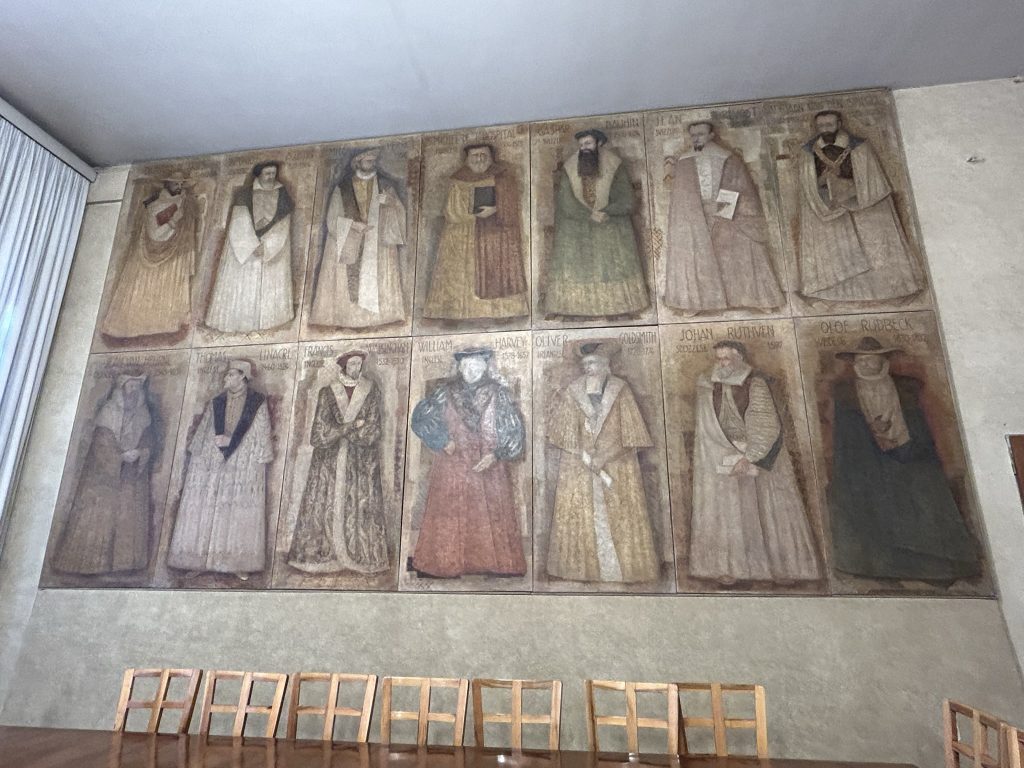
Anatomical Theater at Padua University
Inaugurated in 1595, the anatomical theater at the University of Padua is the world’s first permanent anatomical theater. According to Fabio Zampieri, an associate professor at the university: “To build a permanent theater for anatomy was in some sense revolutionary because it meant to place anatomy as the foundation of medical studies.”
At the time, the Church wasn’t keen on dissecting bodies, so having a purpose-built anatomical theater was kind of a big deal in the evolution of medical knowledge.
The theater is surprisingly tiny and cramped. Back in the day, up to 250 students and professors crowded into the tiered space to look down at the dissection of a human cadaver far below.
Most of the cadavers had belonged either to executed criminals or deceased hospital patients.
With its six elliptical rings circling skyward, the theater seems to mimic the shape of an eye or telescope. Under the main entrance to the theater, a 16th-century Latin inscription reads, “This is a place where the dead are pleased to help the living.”
Cheerful stuff.
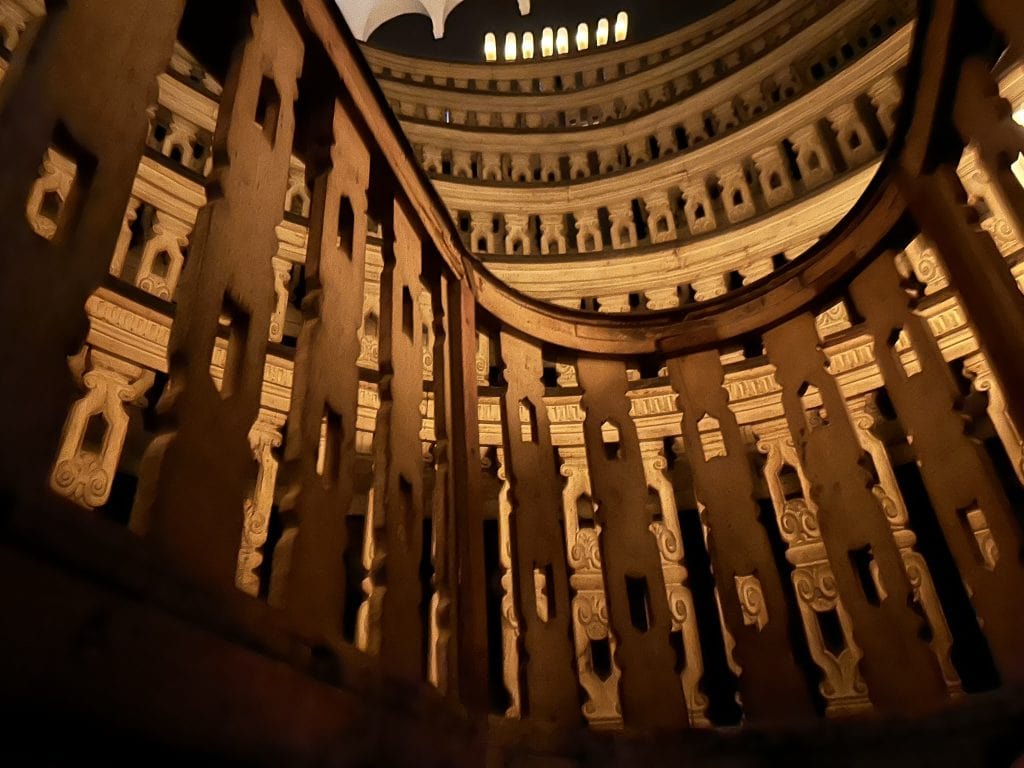
As part of the tour, I ducked under a low door to enter the bottom of the theater where the cadaver would be laid out for the professor to dissect.
It was exceedingly creepy to stand in the narrow space and look up at the six tiers where the spectators would stand. According to the guide, the railing encircling each tier was just high enough to prevent an observer from toppling forward when they fainted.
Apparently, people frequently fainted in the confined–and likely very pungent–space. I shuddered and was happy to move on to the rest of the tour.
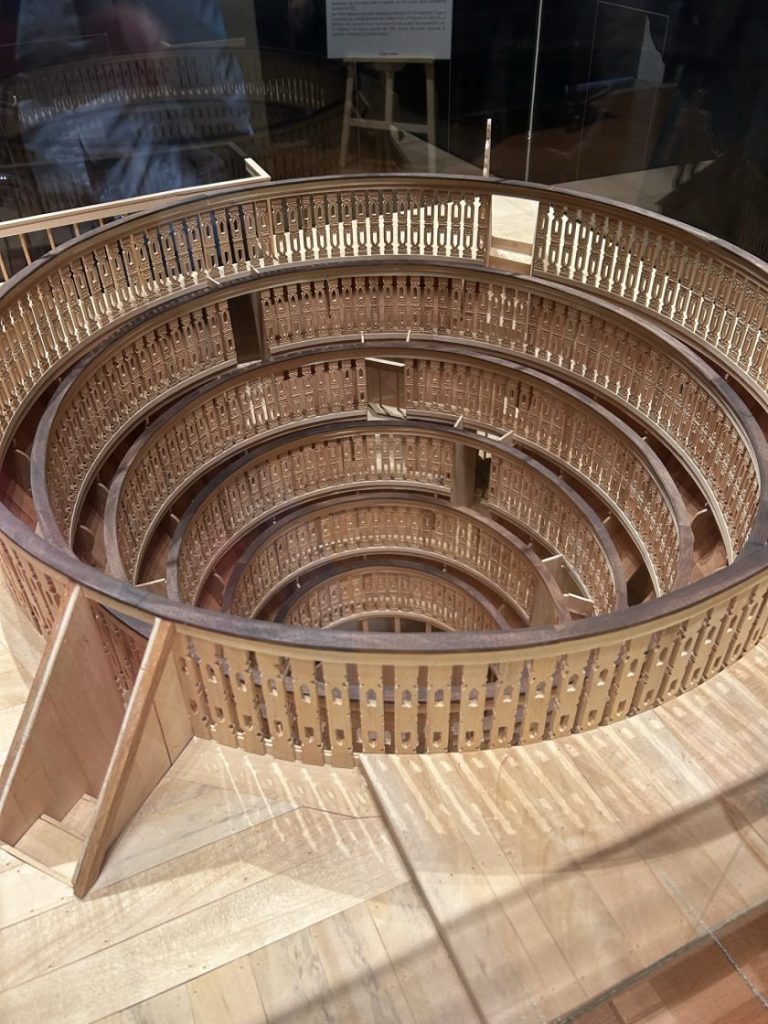
First Woman to Earn a Degree
A highlight at the end of the tour was the statue of Elena Lucrezia Cornora, the first woman in the world to receive a university degree. The daughter of a wealthy Venetian family, she originally wanted to receive a degree in Theology. The bishop of Padua wouldn’t allow that, but did allow her to get a degree in Philosophy in 1678. Big of him.
Palazzo della Ragione
Built in the 13th century, the Palazzo della Ragione is located in the Piazza delle Erbe and resembles a huge upturned ship. Until the fall of the Republic of Venice in 1797, the Palazzo functioned as the town hall and palace of justice.
On the second floor is the Great Hall, believed to be one of the largest medieval halls still existing. A UNESCO World Heritage Site, the walls of the Great Hall are completely frescoed. It’s a pretty impressive place!
Pratto delle Valle
The Pratto delle Valle has to be one of the most beautiful public spaces in Europe. It’s an oval-shaped island encircled by a canal in the center of a grand piazza.
On a brilliantly sunny day in November, it was a delightful place to wander around. Here are two views of the Pratto dell Valle, mercifully uncrowded in mid-morning.
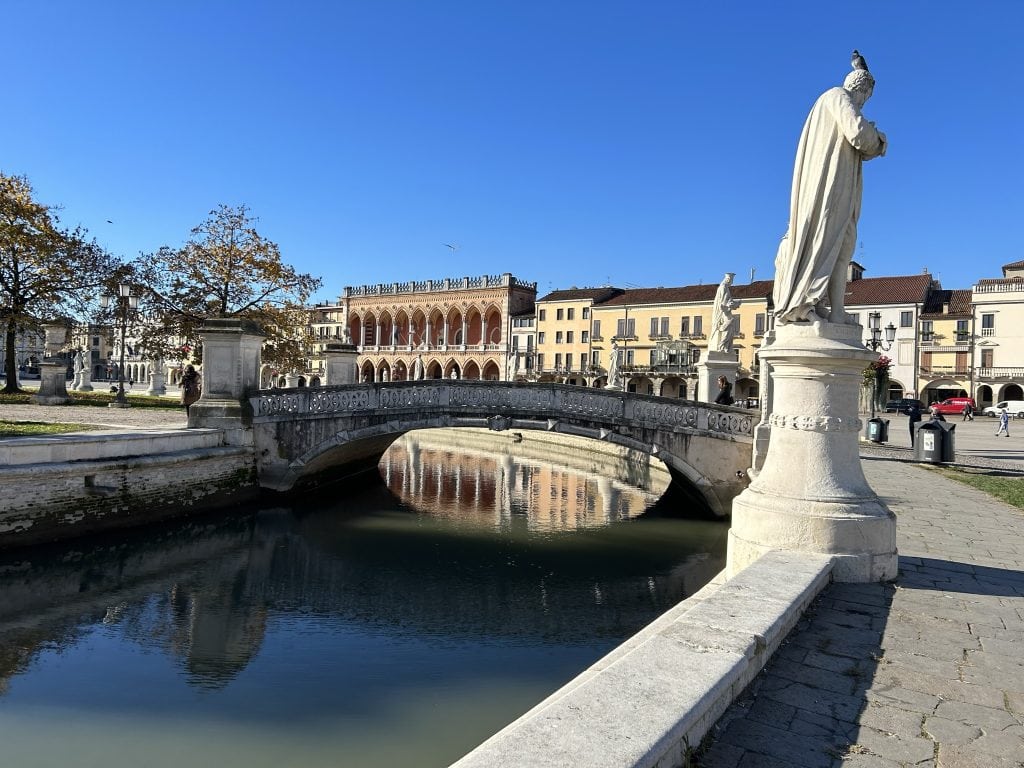
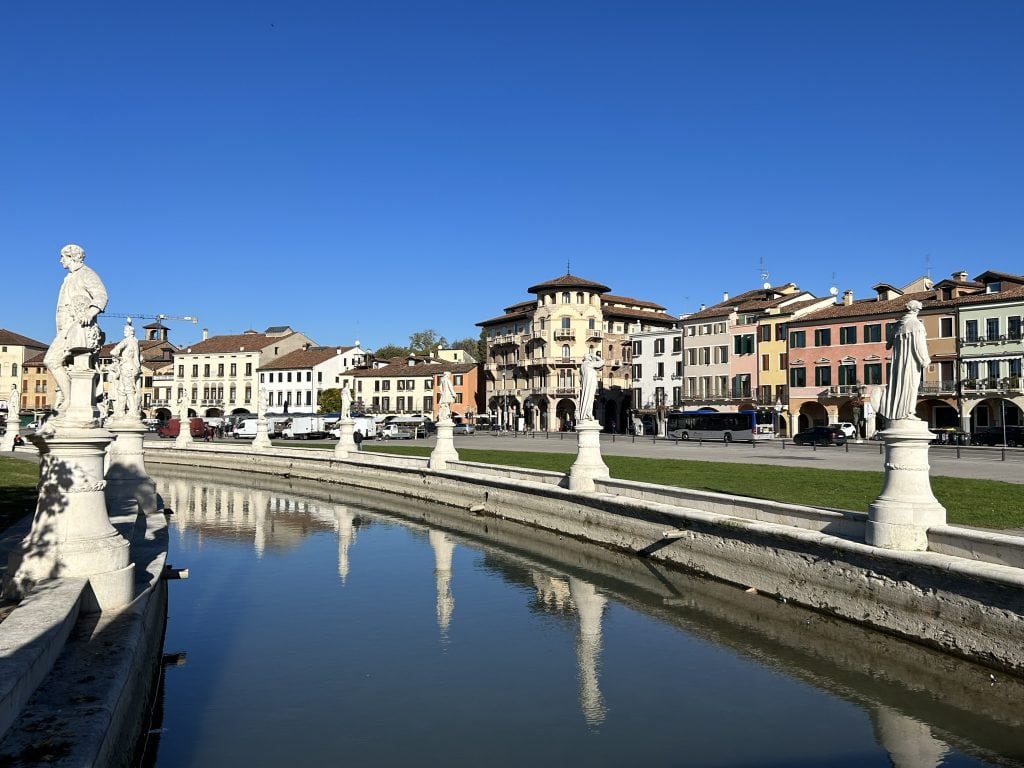
I visited twice–once when it was empty and the second time when it was packed with one of the largest outdoor markets I’ve seen in Europe.
You could buy just about anything you wanted–from clothing to gloves to food to flowers to Christmas decorations. I picked up gloves to ward off the November chill and I treated myself to yet another new purse.
Italy is such a great place to buy purses!
Botanical Gardens
Created in 1545, the botanical garden (Orto Botanico) in Padua is the world’s first botanical garden and is a surprising highlight, even in November.
The garden still preserves its original layout – a circular central plot, symbolizing the world, surrounded by a ring of water. Most of the plants were dormant, but a few trees were still decked out in their autumnal glory.
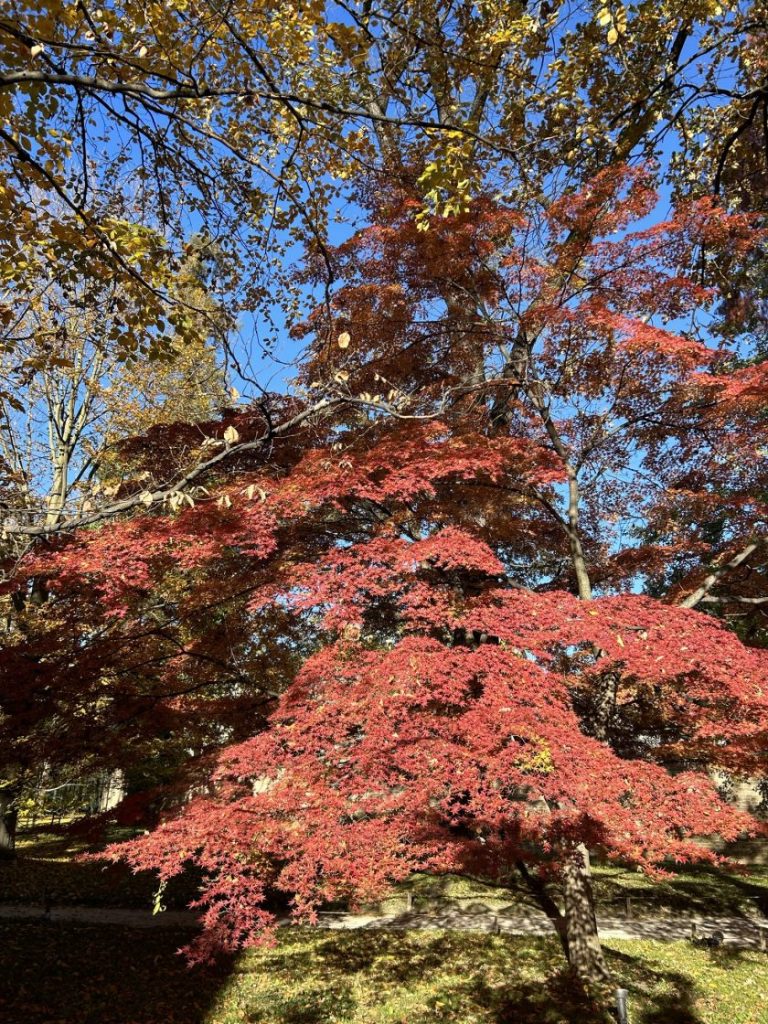
I particularly enjoyed the new exhibition center (inaugurated in February 2023) that is part of the gardens. A series of well laid out displays–many of them interactive (English and Italian)–showcase the history of the botanical garden, its plants, and the people who collected them.
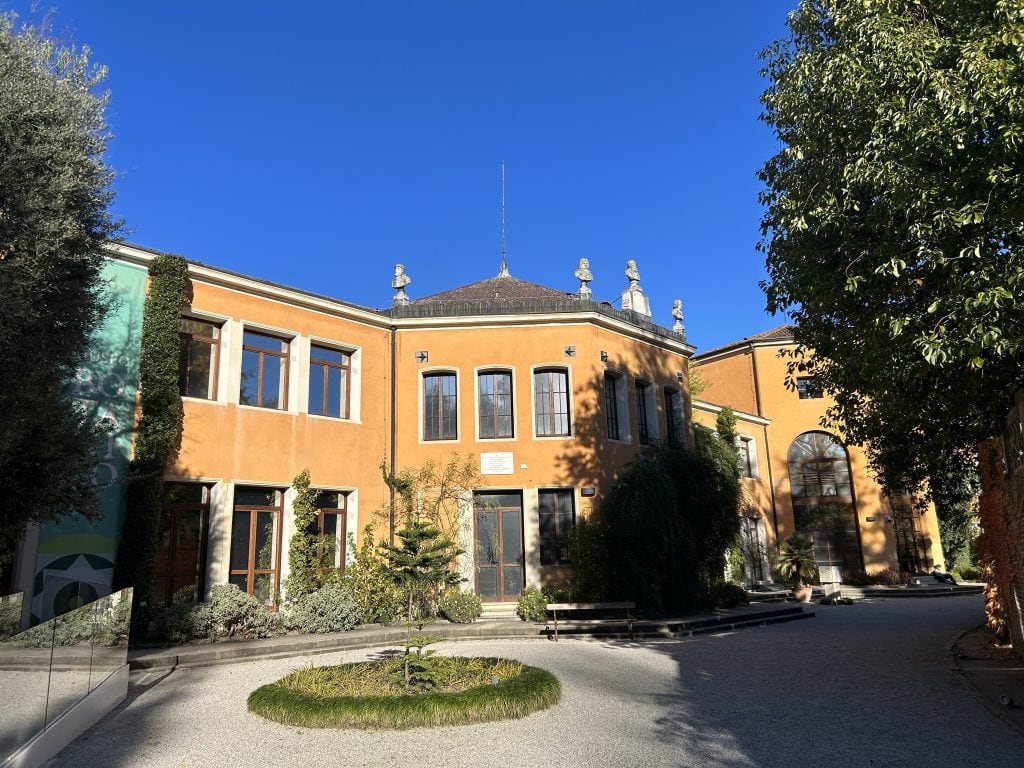
Day Trips from Padua
Thanks to an excellent rail system, Padua is a great home base to make day trips throughout the Veneto region. During my week in Padua, I visited Vicenza and Venice.
If you have the time, you could also visit nearby Verona.
Vicenza Day Trip
Many years ago when I was student studying for a Master’s degree in Drama at the University of Toronto, I had a professor who waxed lyrical about the Teatro Olimpico in Vicenza.
She described how she arrived at the building housing the 16th-century theater just before closing and was denied entry. Apparently, she burst into tears, so intent was she to see this masterpiece of Palladian and theatrical architecture. Fortunately, the guard took pity on her and let her in.
Ever since then, I’ve longed to visit Vicenza’a Teatro Olimpico. This pretty town is a short train ride from Padua, and so I set off on a blue sky day to check it out.
Visit to the Teatro Olimpico
Located in the Piazza Matteotti, a short taxi ride from the train station, the Teatro Olimpico is the world’s first indoor theater constructed with interiors made of wood, stucco and plaster.
The great architect Andrea Palladio built the theater between 1580 and 1585. It is now a UNESCO World Heritage Site.
The design of the theater is inspired by ancient Roman theaters and features an elliptical terraced auditorium, framed by a colonnade, and a frieze topped by statues.
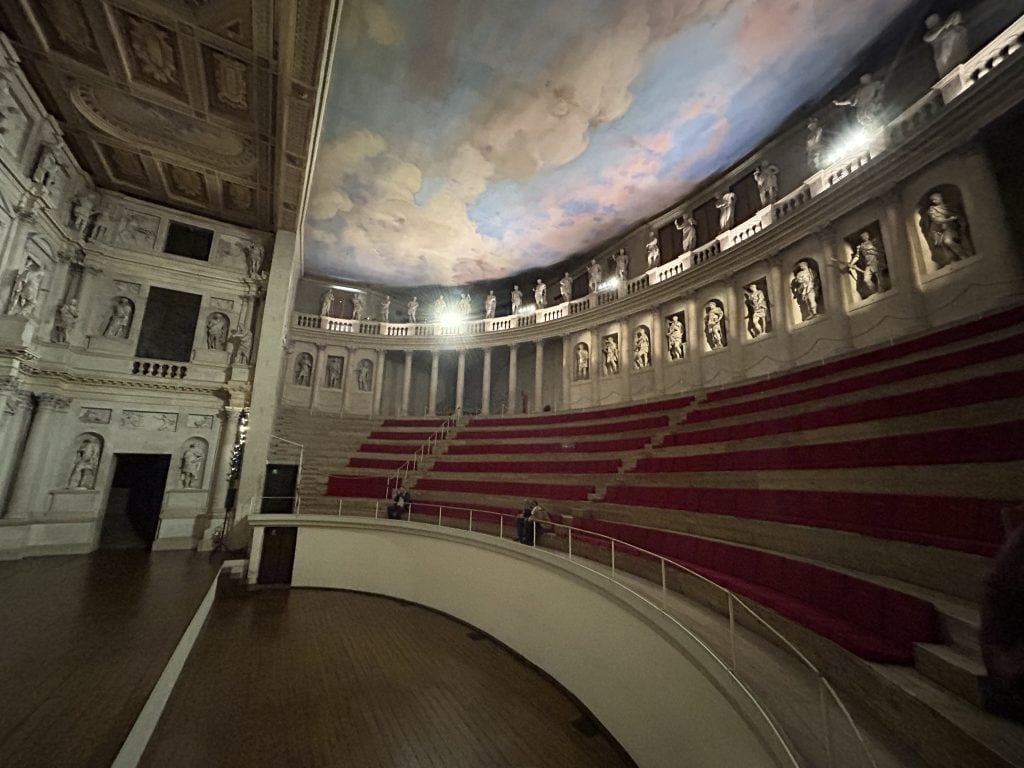
The rectangular stage is bound by a massive proscenium with two orders of architecture and consisting of three arcades that are divided by half-columns. As you sit in the steeply tiered auditorium, you peer into the arcades to see shadowy streets curving into darkness.
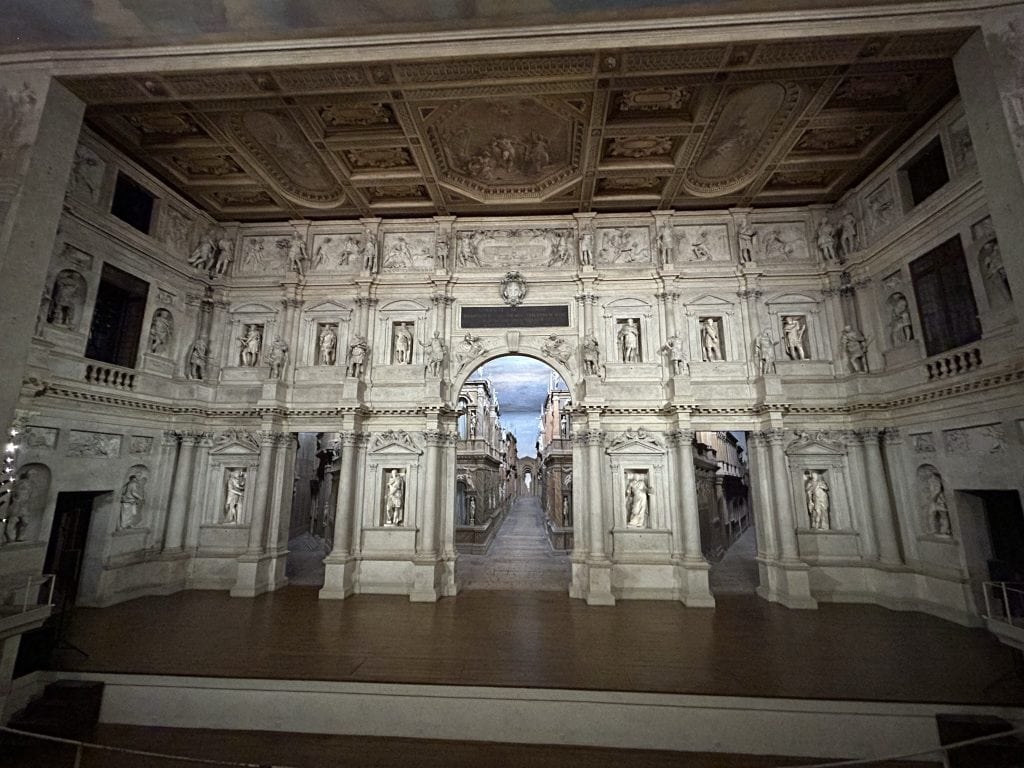
Sound and Light Show at the Teatro Olimpico
At regular intervals, visitors to the Teatro Olimpico are treated to a rousing sound and light show where a myriad of colored spotlights plays across the proscenium to the accompaniment of stirring music.
It’s pretty over-the-top and yet a fitting tribute to the breathtaking beauty of Palladio’s structure.
Here are some glimpses through the archways into a masterpiece of perspective.
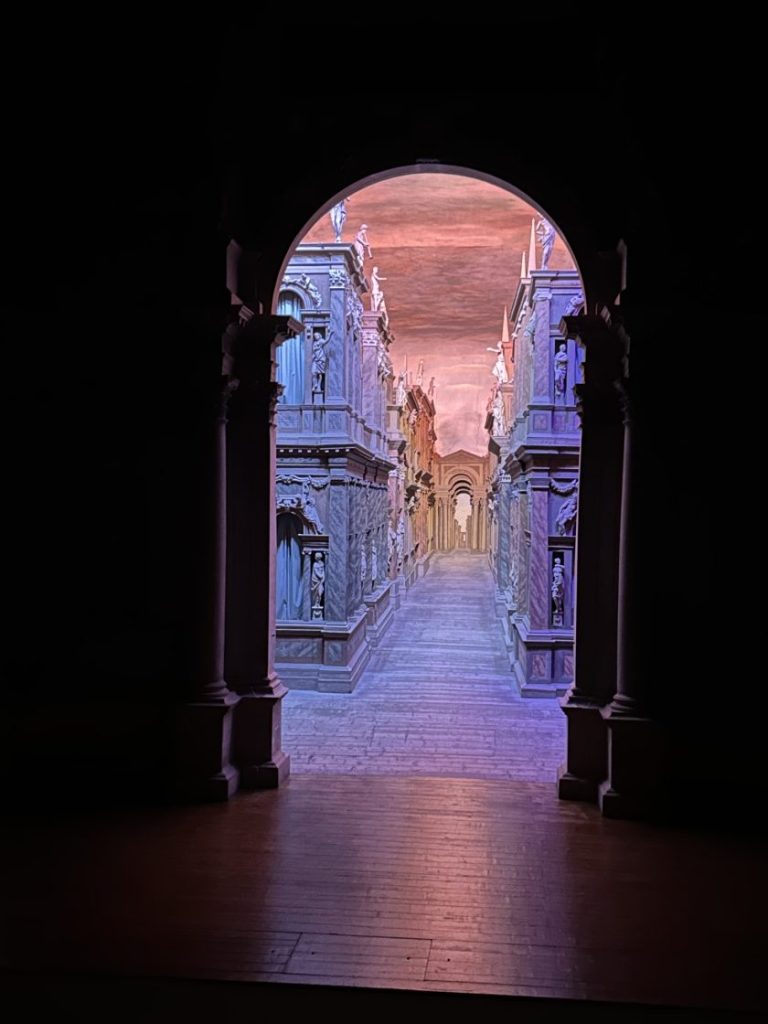
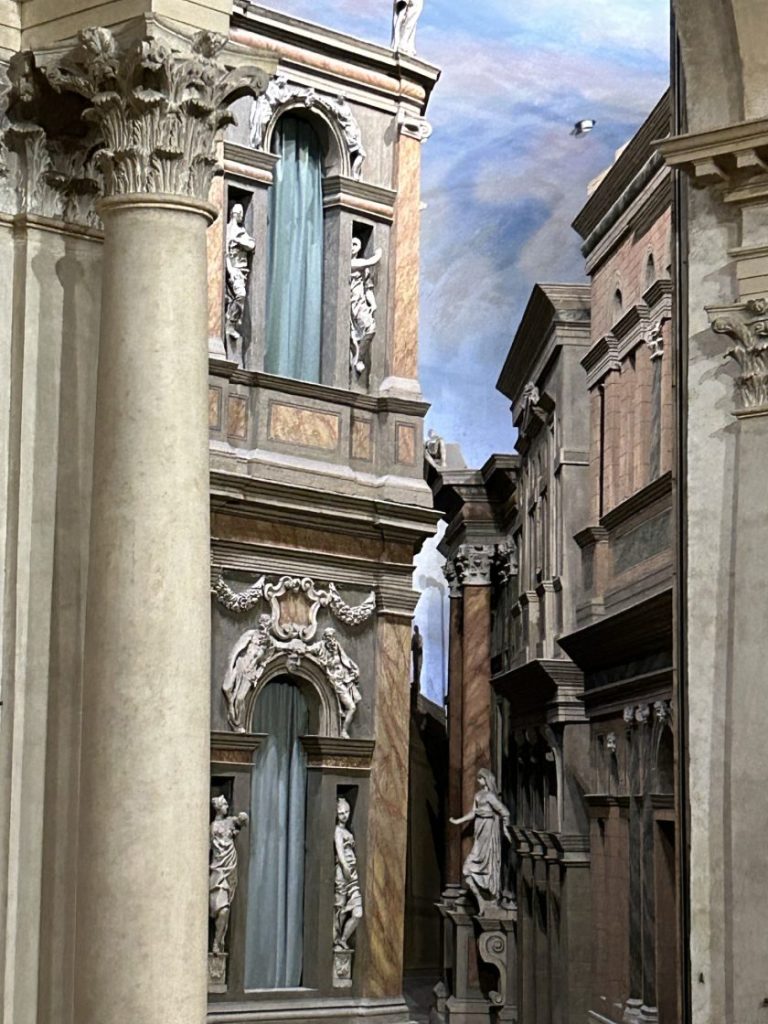
Even if theater history isn’t your thing, a visit to the Teatre Olimpico is a must.
After visiting the theater, I spent a few hours wandering around Vicenza, which I found to be a charming northern Italian town that’s worth an afternoon of your time.
Day Trip to Venice
Venice is only about 30 minutes by train from Padua and so it seemed foolish to take a day trip there. As mentioned, I’ve visited Venice several times, but Venice never disappoints.
The minute I stepped off the train and walked to the edge of the Grand Canal, Venice again worked its magic on me.
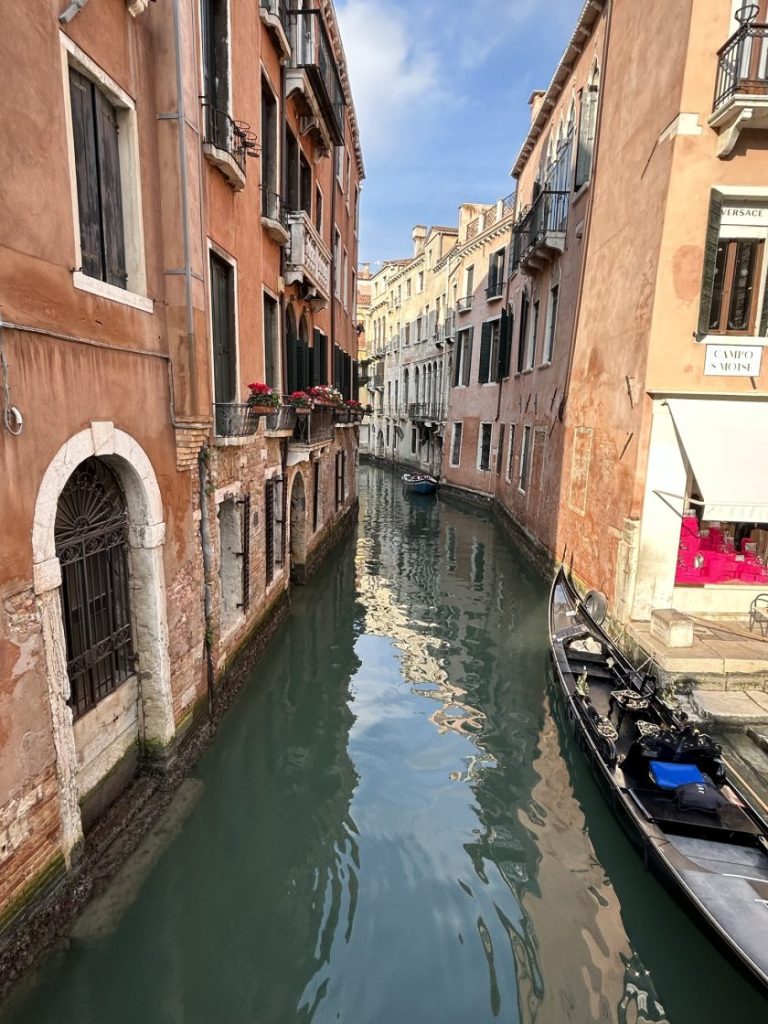
I spent the day–a gloriously sunny one–walking and walking and walking.
I decided not to take a trip on the vaporetto, opting instead to stroll through the Carneggio district to Piazza San Marco, then crossing the Grand Canal on the Accademia Bridge and walking back through the labyrinthine and over peaceful side canals streets to the train station.
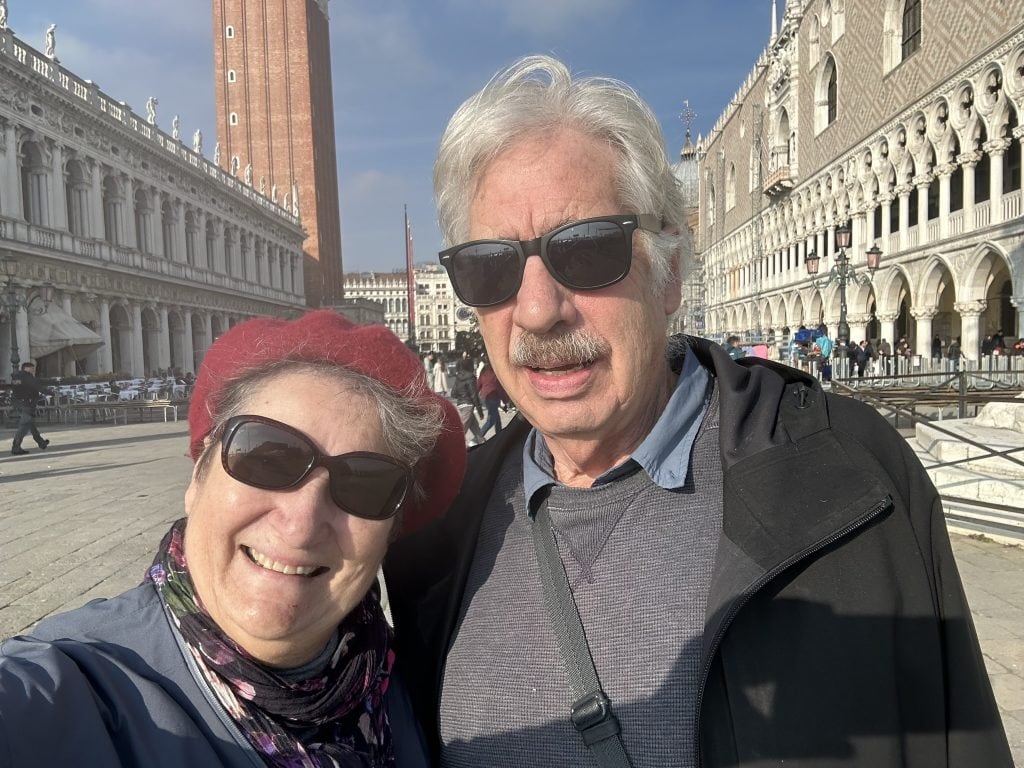
Visit to Saint Mark’s Basilica in Venice
Even in November, Venice was crowded, but a lot less crowded than I’ve seen it at warmer times of the year. For the first time ever, the line-up to get into Saint Mark’s Basilica was short enough to be worth the wait, so finally I got to see inside.
Wow!
The interior of Saint Mark’s Basilica is one giant glitterfest with sparkling golden mosaics covering every available surface. You’ll get a sore neck looking up, but it’s worth it.
I took it all in with awestruck wonder before returning to the Piazzo San Marco to spend an hour or so sitting in the sun and watching the world go by.
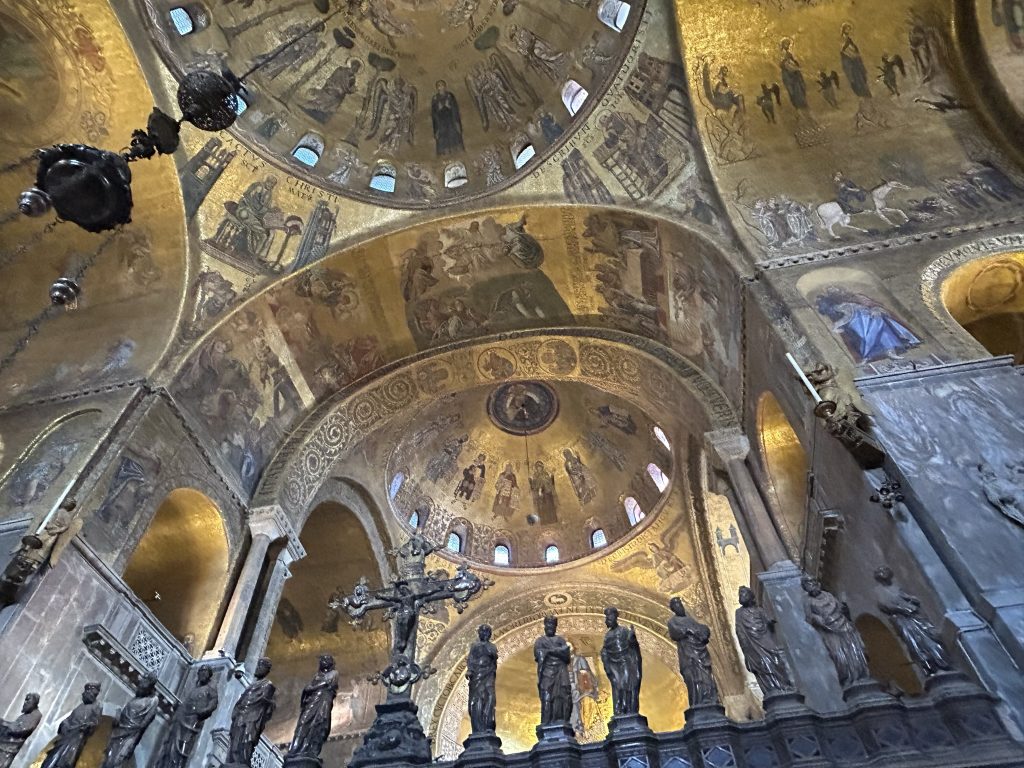
An Exhibition, a Cathedral, and a Quiet Canal
During our week in Padua, I also attended the opening of Gregg’s exhibition at the Queen Art Gallery, had a quick look inside the impressive cathedral (the Basilica di Sant’Antonio), and enjoyed many walks alongside peaceful canals slumbering in the autumn sunshine.
While Padua has several worthy tourist sites, it’s not a particularly touristy town. The vast majority of people out on the streets are locals, and many are students from the university which gives the town a youthful, vibrant feel.
It’s an easy town to walk around with plenty to look at along the way.
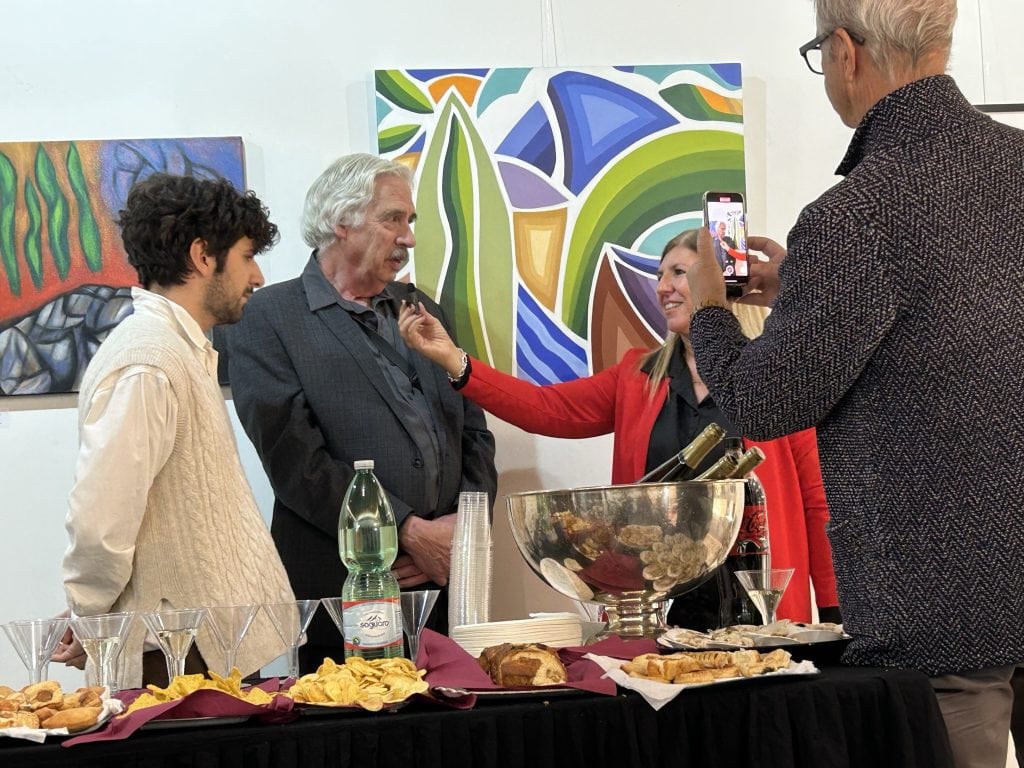
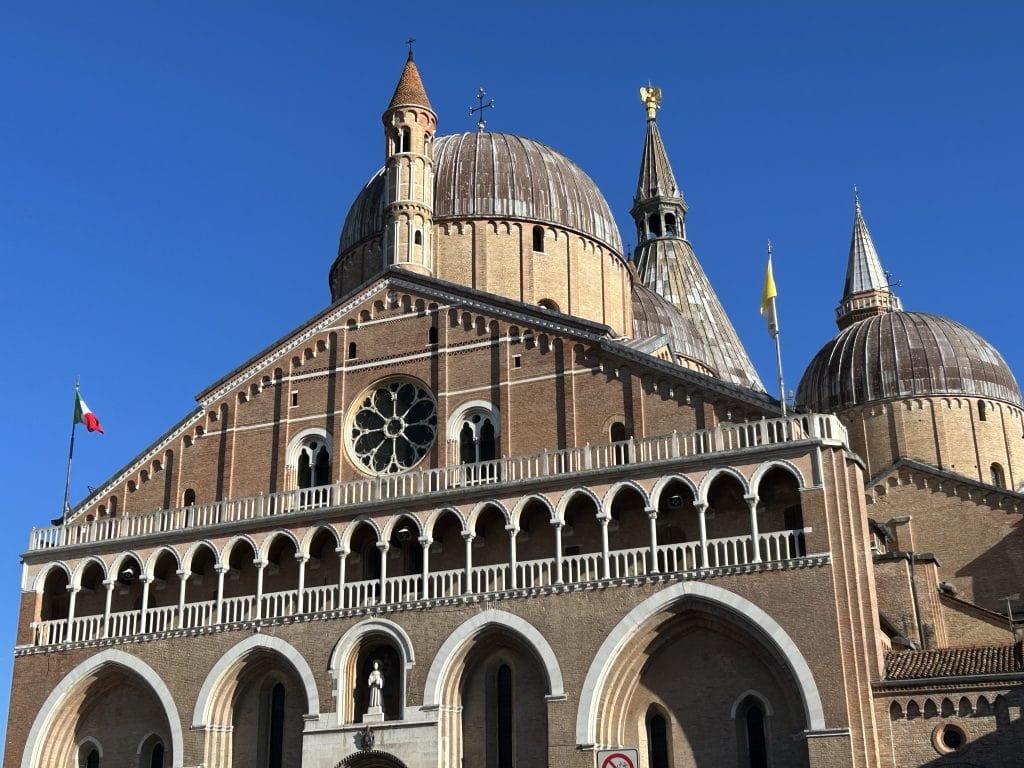
Home Away From Home in Padua
Gregg and I stayed in a two-bedroom apartment not far from the train station in Padua. While the neighborhood was, admittedly, a bit nondescript, it included plenty of food shops, fast-food joints, and restaurants, and was within walking distance of the train station and the center of Padua.
Here’s a shot of a typical canal side scene that I passed pass on my way from the apartment into Padua’s historic center.
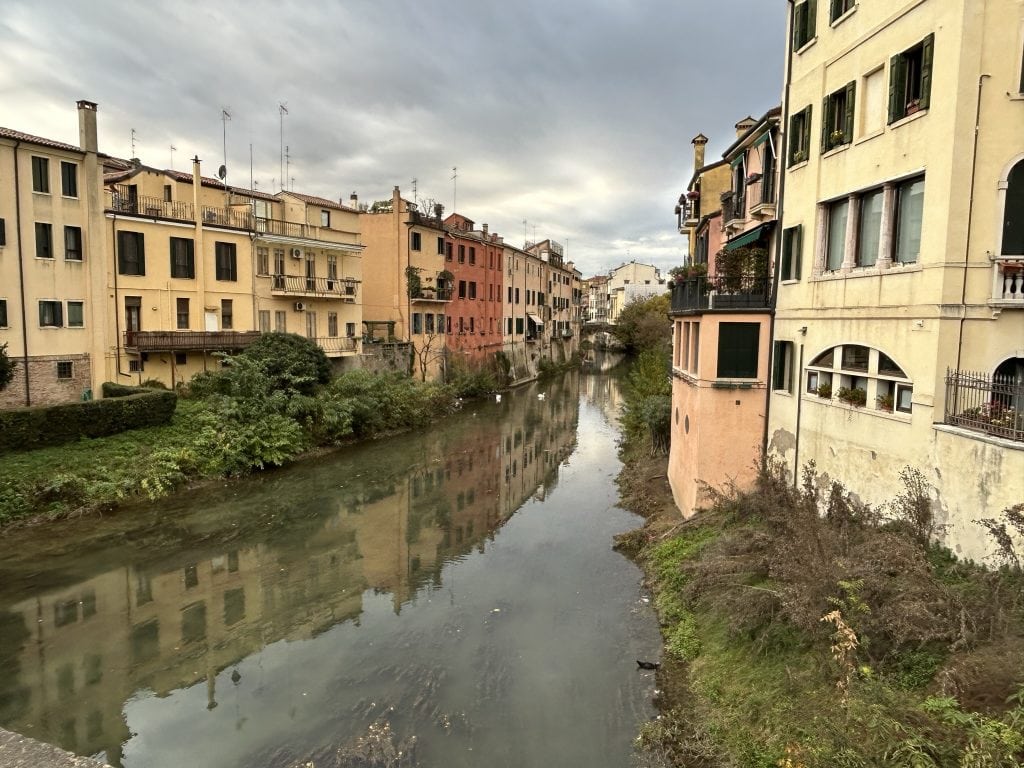
I chose the apartment for its location near the edge of Padua because we were driving and did not want to try navigating the medieval streets of old Padua. The apartment came with a parking place, which turned out to be accessible via a car elevator.
Here’s a shot of us retrieving our car at the end of our eight-night stay.
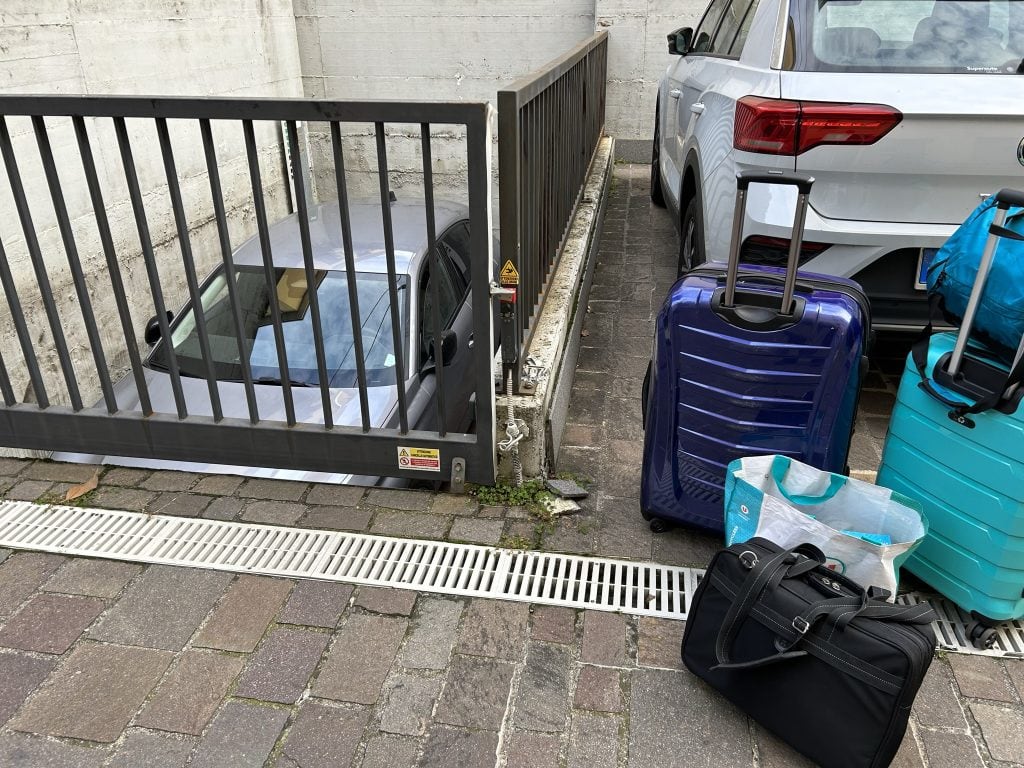
I highly recommend this apartment if you’re looking for comfortable accommodations that won’t break your budget.
The map below shows many other options for hotels and apartments in Padua.
Tours and Tickets in Padua
Here are some options for tours and tickets in Padua from Tiqets.com
Conclusion
Have you visited Padua? What sites do you recommend? Let other Artsy Travelers know your thoughts in the comments below.
